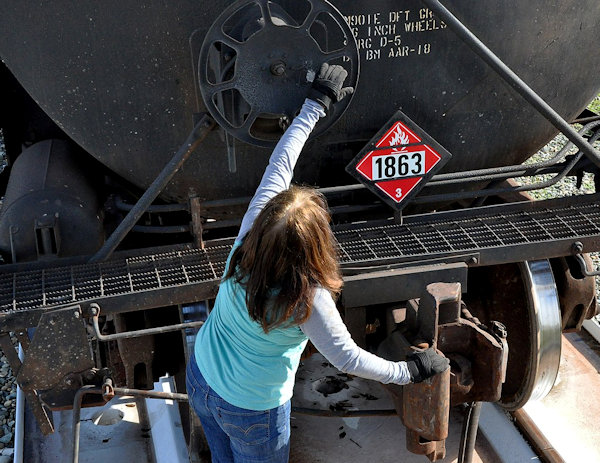SEJournal Online is the digital news magazine of the Society of Environmental Journalists. Learn more about SEJournal Online, including submission, subscription and advertising information.
 |
| Placards on the sides of railcars help identify hazmat inside. Above, a locomotive engineer disconnects a rail car carrying flammable jet fuel from Texas to Beale Air Force Base in California. Photo: U.S. Air Force/Staff Sgt. Jeffrey M. Schultze, Public domain, via Wikimedia Commons. |
Reporter’s Toolbox: Coming Your Way by Rail Today — A Hazmat Rogues’ Gallery
By Joseph A. Davis
If your community is concerned about hazardous chemicals rolling by on freight trains — as it well might be in the wake of the East Palestine, Ohio, derailment — the best time for you as an environmental journalist to understand the risk is before an accident happens.
It also helps to know what the worst hazardous materials are.
Most railcars don’t carry hazardous
materials. But some do. Things that
are toxic, flammable, corrosive,
explosive and radioactive.
First, the good news: Most railcars don’t carry hazardous materials. Instead, they carry fairly inert, heavy stuff. Coal. Gravel. Soybeans. Cars. Even newsprint. Mostly harmless.
Now the bad news: Some railcars do carry hazardous materials. Things that are toxic, flammable, corrosive, explosive, radioactive, etc.
A list of lists
To know what that hazmat is, you can read the hazmat placards on the sides of railcars. But you should also have a working list of the worst offenders.
Fortunately, there are a lot of lists. One of our favorites is the U.S. Environmental Protection Agency’s “list of lists.” You can get it as a spreadsheet, but it’s pretty big. So you might settle for a shorter list like that from the Toxics Release Inventory, although that would leave some out.
Some of the worst are in the EPA’s Risk Management Program list. Using the diamond-shaped placards on the side of railcars allows you to identify contents by UN number — a practical identifier for hazmats shipped in commerce assigned by a group of experts at the United Nations.
So, for instance, you say vinyl chloride, and we say: UN 1086
You can find a list of UN numbers and there’s a lookup app for your phone as well (Apple or Android).
The worst of the worst
Here is a kind of rogues’ gallery of hazmats to worry about — not only because they cause harm but also because they are common. This is only a short list of the worst, so check the fuller lists for more.
- Vinyl chloride (UN 1086): The stuff that spilled at East Palestine, pretty common because it is used to make plastic, is a hazmat not only because it is toxic, but also because it releases other toxic substances (like dioxins) when it burns. It is carried in railcars as a pressurized gas.
- Chlorine (UN 1017): Shipped as a liquid in 18,000 gallon pressurized tank cars, if released it hugs the ground and could potentially kill thousands of people in low concentrations.
- Crude Oil (UN 1267): Quite flammable, more so when it is in a damaged 100-car unit train. Remember Lac-Mégantic.
- Gasoline (UN 1203): A highly volatile and flammable petroleum distillate.
- Kerosene (UN 1223): A highly volatile and flammable petroleum product; used to make jet fuel (UN 1863).
- Liquified Natural Gas (UN 1972): Flammable and explosive unless refrigerated. The Trump administration made it legal to ship by rail. The Biden administration is making it illegal.
- Propane (UN 1978): A flammable gas shipped in compressed form.
- Butane (UN 1011): A flammable gas shipped as a liquid.
- Fireworks (UN 0333): These may be OK on July Fourth. The problem is getting them shipped without them exploding.
- Ethanol (UN 1170): A flammable liquid shipped in large quantities, which means a wicked fire if a unit train crashes.
- Anhydrous Ammonia (UN 1005): Used as a fertilizer and refrigerant, this gas is shipped as a liquid and is a toxic inhalation hazard.
- Ammonium Nitrate (UN 1942): Typically shipped in crystalline form and used for fertilizer and making explosives, it can be highly explosive.
- Sulfuric Acid (UN 1830): The world's largest volume industrial chemical, used to make phosphate fertilizers, explosives, other acids, dyes, glue, wood preservatives, etc.
- Nitric Acid (UN 2032): This red, fuming acid will eat your skin, corrode metal and suffocate you. It reacts with water.
- Hydrofluoric Acid (UN 1790): This acid, used to make refrigerants, gasoline and many other products, is highly corrosive of metals, glass and flesh and is a toxic inhalation hazard.
- Propylene (UN 1077): Shipped as a liquefied gas, this highly flammable substance, whose containers may explode, is used in large quantities for making plastics and other products.
- Ethylene Oxide (UN 1040): This gas is used for various industrial processes, including disinfection. It is flammable, explosive and toxic. It reacts with many other industrial chemicals shipped by rail.
[Editor's Note: Also see our recent TipSheet on finding the secret rail hazmat routes near you. And for more on hazmat transport, also see a TipSheet on LNG transport and a recent Toolbox on highway hazmat routes.]
Joseph A. Davis is a freelance writer/editor in Washington, D.C. who has been writing about the environment since 1976. He writes SEJournal Online's TipSheet, Reporter's Toolbox and Issue Backgrounder, and curates SEJ's weekday news headlines service EJToday and @EJTodayNews. Davis also directs SEJ's Freedom of Information Project and writes the WatchDog opinion column.
* From the weekly news magazine SEJournal Online, Vol. 8, No. 12. Content from each new issue of SEJournal Online is available to the public via the SEJournal Online main page. Subscribe to the e-newsletter here. And see past issues of the SEJournal archived here.













 Advertisement
Advertisement 



